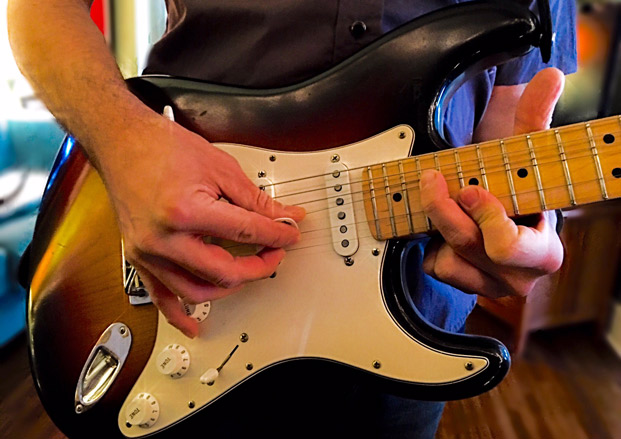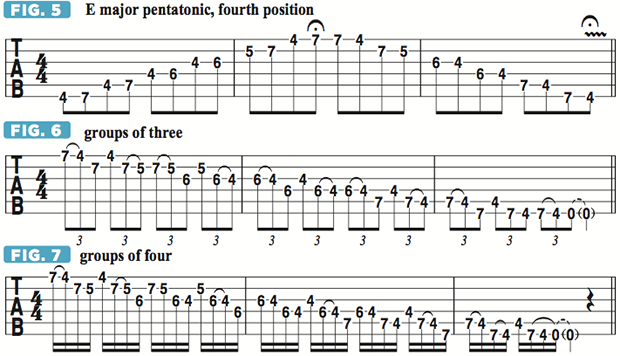How to Use Various Major-Pentatonic Shapes for Soloing

Most guitarists will agree that the study of scales is an endeavor that will reap many benefits.
Along with helping one to learn the “map” of the fretboard in any given position, studying scales reinforces note recognition all over the fretboard while also instilling a broader range of muscle memory in regard to the way one physically navigates the board via repetitive finger movement.
In other words, your fingers will adapt to new specific movement patterns as you move from one pattern and position to the next. The greatest benefit of this endeavor is that it helps you from habitually falling into “lick”-type phrases that so many guitarists find themselves stuck with.
We all must learn licks in the pursuit of developing our soloing abilities, and the next step is to break those lick habits and instead use your ear to listen to the many melodic possibilities that can be discovered as you play. FIGURE 1 illustrates the E major pentatonic scale played in first position, utilizing open strings.
A great way to play this pattern is to keep your index finger at the first fret and your remaining fingers at the second, third and fourth frets. This way, there will be no need for moving out of position while playing the notes of the scale.
As a general guideline, ascending and descending through groups of threes and fours is a great way to memorize a scale position; FIGURE 2 illustrates descending in three-note groups through the pattern, and FIGURE 3 has you descending in groups of four. Now let’s look at how you can improvise melodies while staying within this position of E major pentatonic.
FIGURE 4 offers an example. As I play, I’m simply moving my fingers among notes that are found in the scale in a variety of different patterns and listening to the results. In this way, I’m thinking more about navigating through the scale in this position as opposed to playing licks that I know or licks that I might always find myself typically playing.
And as you move up the fretboard, you will discover that each scale position and pattern will offer different melodic patterns as a product of the way the notes lay on the board. FIGURE 5 shows E major pentatonic as it falls in fourth position, and FIGURES 6 and 7 illustrate descending groups of threes and fours, respectively, played in this pattern, or shape.
Once your fingers become accustomed to the shape, try soloing in a free and random way while listening to the melodic contour of the lines and letting your ear decide which note to play next. The next step is to continue the process by moving up through all scale positions of E major pentatonic and then improvising in each new area.


Get The Pick Newsletter
All the latest guitar news, interviews, lessons, reviews, deals and more, direct to your inbox!
Guitar World Associate Editor Andy Aledort is recognized worldwide for his vast contributions to guitar instruction, via his many best-selling instructional DVDs, transcription books and online lessons. Andy is a regular contributor to Guitar World and Truefire, and has toured with Dickey Betts of the Allman Brothers, as well as participating in several Jimi Hendrix Tribute Tours.










![Joe Bonamassa [left] wears a deep blue suit and polka-dotted shirt and plays his green refin Strat; the late Irish blues legend Rory Gallagher [right] screams and inflicts some punishment on his heavily worn number one Stratocaster.](https://cdn.mos.cms.futurecdn.net/cw28h7UBcTVfTLs7p7eiLe.jpg)
